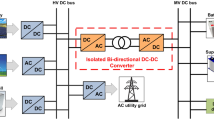Abstract
Aiming at the problems of poor quality of the output voltage waveform of the existing multi-level inverters and many switching devices and DC power supplies, a novel cascadable basic unit topology is proposed. The proposed topology consists of three input DC power supplies and eight switches, forming an H half-bridge and an auxiliary bidirectional switch by adding 2 DC power supplies in the traditional H-bridge topology. The advantage of this topology is that it can be used in symmetric and asymmetric voltage source configurations, which can effectively extend the life of the inverters and reduce the production cost. The basic unit topology is cascaded in series to form a multilevel inverter topology to generate higher voltage levels, and its power balance strategy is proposed. The strategy can be described as follows: Firstly, several groups of pulse signals are generated by the traditional LS-PWM modulation strategy in which the modulation wave is compared with several groups of carriers, then a logic operation on the pulse signals is performed to obtain the drive signal of each switch, and the inverter is driven to achieve output power balance. A lot of Simulation and experiments verify the viability of the proposed topology and the effectiveness of the equalization strategy.























Similar content being viewed by others
References
Dargahi J et al (2019) Fundamental circuit topology of duo-active-neutral-point-clamped, duo-neutral-point-clamped, and duo-neutral-point-piloted multilevel converters. IEEE J Emerg Sel Top Power Electron. 7(2):1224–1242
Yousofi-Darmian S, Masoud Barakati S (2020) A new asymmetric multilevel inverter with reduced number of components. IEEE J Emerg Sel Top Power Electron. 8(4):4333–4342
Han J, Tang T, Tan X (2007) A novel hybrid cascade asymmetrical multilevel inverter. Trans China Electrotech Soc 12(22):110–115
Sarbanzadeh M, Babaei E, Hosseinzadeh MA, Cecati C (2016) A new sub-multilevel inverter with reduced number of components. In: IEEE industrial electronics society conference, 3166–3171
Babaei E, Alilu S, Laali S (2014) A new general topology for cascaded multilevel inverters with reduced number of components based on developed H-bridge. IEEE Trans Ind Electron 61(8):3932–3939
Babaei E, Laali S, Bayat Z (2015) A single-phase cascaded multilevel inverter based on a new basic unit with reduced number of power switches. IEEE Trans Ind Electron 62(2):922–929
Alishah RS, Hosseini SH, Babaei E, Sabahi M (2017) Optimal design of new cascaded switch-ladder multilevel inverter structure. IEEE Trans Ind Electron 64(3):2072–2080
Ye M, Lin M (2020) Single source step-up multilevel based on switched-capacitor. Proc CSEE 40(17):5636–5644
Siddique MD, Mekhilef S, Shah NM, Ali JSM, Blaabjerg F (2020) A new switched capacitor 7L inverter with triple voltage gain and low voltage stress. IEEE Trans on Circuits and Systems II Express Briefs. 67(7):1294–1298
Taheri A, Samsami H (2019) New topology of a switched–capacitor based multilevel inverter with a single dc power supply. IET Power Electron 12(6):1571–1584
Ye Y, Chen S, Hua T (2021) A novel switched-capacitor seven-level inverter with low voltage stress. Proc CSEE 41(13):4628–4636
Khoun-Jahan H et al (2021) Switched capacitor based cascaded half-bridge multilevel inverter with voltage boosting feature. CPSS Trans Power Electron Appl 6(1):63–73
Chen Z, Xu Y, Na X, Sun J (2018) Power balance control and optimization methods with output voltage rotation for cascaded multilevel inverter. Proc CSEE 38(4):1132–1142
Taheri A, Samsami H (2019) Novel topology of a switched–capacitor based multilevel inverter with a single DC power supply. IET Power Electron 12(6):1571–1584
Chen Z, Xu Y, Na X, Sun J (2017) Power balance control method with phase disposition for cascaded H-bridge inverter based on control degrees of freedom combination. Proc CSEE 37(23):6951–6961
Saeed YD, Barakati SM (2020) A new asymmetric multilevel inverter with reduced number of components. IEEE J Emerg Sel Top Power Electron. 8(4):4333–4342
Panda P, Bana PR, Panda G (2020) A switched-capacitor self-balanced high-gain multilevel inverter employing a single DC source. IEEE Trans Circuits Syst II Express Br 67(12):3192–3196
Samadaei E, Kaviani M, Bertilsson K (2019) A 13-levels module (K-type) with two dc sources for multilevel inverters. IEEE Trans Ind Electron 66(7):5186–5196
Kouro S, Malinowski M, Gopakumar K, Pou J, Franquelo LG, Wu B, Rodriguez J, Perez MA, Leon JI (2010) Recent advances and industrial applications of multilevel converters. IEEE Trans Ind Electron 57(8):2553–2580
Alishah RS, Nazarpour D, Hosseini SH, Sabahi M (2015) Reduction of power electronic elements in multilevel converters using a new cascade structure. IEEE Trans Industr Electron 62(1):256–269
Rahim NA, Chaniago K, Selvaraj J (2011) Single-phase seven-level grid-connected inverter for photovoltaic system. IEEE Trans Industr Electron 58(6):2435–2443
Funding
This work was supported by the National Natural Science Foundation of China under Grant 61561007, and in part by the Natural Science Foundation of Guangxi Province, China, under Grant 2017GXNSFAA198168.
Author information
Authors and Affiliations
Corresponding author
Additional information
Publisher's Note
Springer Nature remains neutral with regard to jurisdictional claims in published maps and institutional affiliations.
Rights and permissions
Springer Nature or its licensor holds exclusive rights to this article under a publishing agreement with the author(s) or other rightsholder(s); author self-archiving of the accepted manuscript version of this article is solely governed by the terms of such publishing agreement and applicable law.
About this article
Cite this article
Xue, B., Gong, R., Liu, J. et al. A Novel Inverter Topology and its Power Balancing Optimization. J. Electr. Eng. Technol. 18, 2015–2026 (2023). https://doi.org/10.1007/s42835-022-01268-z
Received:
Revised:
Accepted:
Published:
Issue Date:
DOI: https://doi.org/10.1007/s42835-022-01268-z




